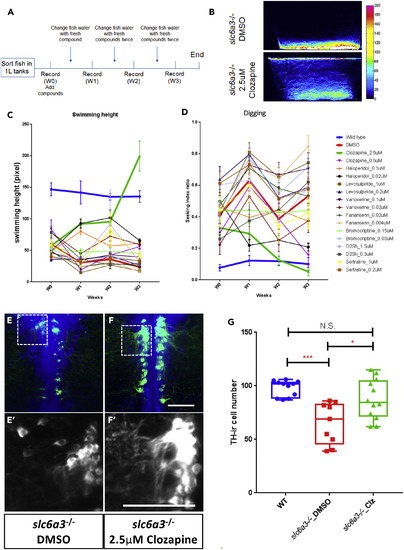Fig. 3
- ID
- ZDB-FIG-190909-2
- Publication
- Wang et al., 2019 - Abnormal Behavior of Zebrafish Mutant in Dopamine Transporter Is Rescued by Clozapine
- Other Figures
- All Figure Page
- Back to All Figure Page
|
Chronic Clozapine Treatment Rescues Aberrant Swimming Behavior and Midbrain TH+ Neurons in the slc6a3−/− Fish Brain (A) Schematic of the experimental design for chronic treatment of slc6a3−/− allele1 mutant fish with candidate compounds. (B) The heatmap of fish trajectories of control (DMSO) and 2.5 μM clozapine-treated slc6a3−/− allele1 fish after 3 weeks' treatment showing that clozapine reverses aberrant “digging” behavior. (C) Time course of swimming height from week 0 (W0) to week 3 (W3) (n = 5; error bar = standard deviation). (D) The time course of the “digging” feature duration by all compounds over time (n = 5, error bar = standard deviation). (E–F) Representative images of TH+ neurons in (E and E′) DMSO and (F and F′) 2.5 μM clozapine-treated slc6a3−/− allele1 fish brain in the A8 area at 3 months post-fertilization showing restoration of neuronal number and arborization by clozapine. For visualization purpose, images are shown as horizontal ventral views, with anterior on the top. Five optical planes (6-μm interval) were stacked to show the TH+ cells. Scale bar, 20 μm. (G) Boxplot shows clozapine-induced restoration of TH-immunoreactive A8 cell number in slc6a3−/− allele1 fish at 3 months post-fertilization. (For all, n ≥10. Error bar = standard deviation. ***p < 0.001, *p < 0.05. N.S., no significance. Significance test: one-way ANOVA Kruskal-Wallis test). |
| Antibody: | |
|---|---|
| Fish: | |
| Condition: | |
| Anatomical Term: | |
| Stage: | Adult |
| Fish: | |
|---|---|
| Condition: | |
| Observed In: | |
| Stage: | Adult |

